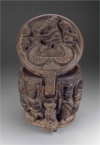Lectures 16&17 Flashcards
(11 cards)

Georges Seurat, Sunday Afternoon at the Grande-Jatte, 1886
- color theory: any object has local color- mixture takes place optically vs on palate
- cover entire surface with small paint strokes
- space of leisure where classes mix
access to leisure- nobody is joyful, stiff, carves their own space, alienation
- 11 colors- purest hue of each that he could ifnd
- official day of for French working families
- social hierarchy in parisian parks- lower class industrial area- range of lower-middle class

Gustave Eiffel, Eiffel Tower, 1887-9
- 100th anniversary of french revolution
- technological mite of France
- massively tall but light structure- doesnt sway in wind

Vincent Van Gogh, Starry Night, 1889
- painted from careful observation and the artist’s imagination- still paints naturalistically but pushes it to extremes w/ color
- sky pulsate with celestial rhythms and blazes with exploding stars- dynamic energy through brush strokes
- idea of life and death- cypress tree- traditional symbol of both death and eternal life which rises dramatically to link the terrestrial and celestial realms
- brightest star is actually Venus, associated with love
- van gogh’s euphoric hope of gaining in death the love that eluded him in life
- rail like strokes of intense color writhe across its surface
- brushwork is immediate, expressive, and intense
- 3 dimmensionality to paint strokes

Paul Gaugin, Where do we come from? What are we? Where are we going? 1897-8
–represents the motions of life- young to old
- vivid use of colors- thick brushstrokes
- voyeuristic/anthropological view of “exotic” society
sexualizes the other
jesus loin cloth- picking fruit

Yinka Shonibare, Scramble for Africa, 2003
14 life-sized fiberglass mannequins, 14 chairs, table, and Dutch wax printed cloth
- splitting up africa- headless unthinking men
- wearing dutch cloths- trade triangle

Gelede Mask, Yoruba
20th century wood
women as foundation of society
snake

Sowei Mask, 19th-early 20th century Wood -only mask women solely wore
polished surface (skin)
eyelashes
intricate hair
neck rolls like

Olowe of Ise, Veranda posts installed in the Courtyard of the Palace of the Ogaga of Ikere, 1910-1914. Wood and pigment. Yoruba Peoples. Nigeria.
-family portrait-
king seated on throne- distintive crown- w/heads &birds
liminal-part human but part divine
elongated nek
healer at bottom- inbetween of public and royal family
king smaller than queen mother who conduts business
-tall, elegant, gazing fearsome- painted in greater detail
dynamism w/ single post of wood
- long necks and elaborate hairstyle make them appear even taller, in such high relief that upper portions are actually carved in the round
- figures move energetically against an underlying decorative pattern and entire surface of door

Satirical Egungun: European Couple Illogbo, Awori, Nigeria, 1982.
-holding a pen, seen together-stereotypes of european tourists

Ifa divination board, Opon ifa, 17th century. Wood. Yoruba peoples
- way for people to get in control of their lives
- trickster god- sent to prussian king
cowry shells, palm nuts (to read signs), ivory tapper

Areogun of Ise –Ilori, Orisha Priest’s Bowl, wood
-pipe in mouth
shallow relief-center bicycle
someone carrying a book
geometric patterns to mark edges


